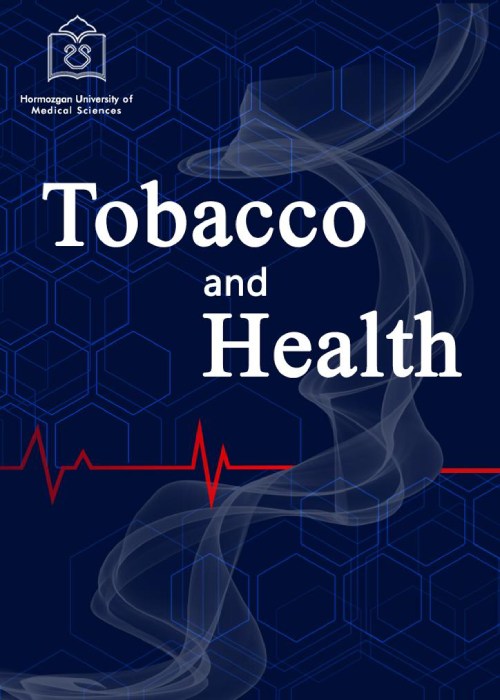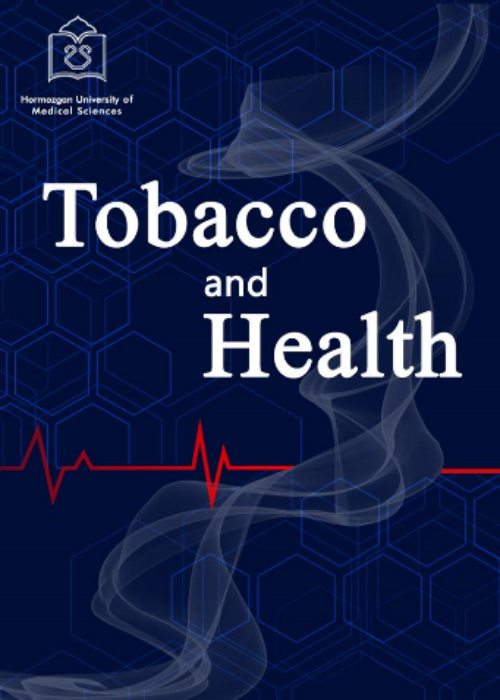فهرست مطالب

Tobacco and Health
Volume:2 Issue: 1, Jan 2023
- تاریخ انتشار: 1401/12/27
- تعداد عناوین: 8
-
Pages 1-4Background
Coronary artery disease (CAD) is the most common type of cardiovascular disease (CVD) and has a high mortality and morbidity rate. Smoking is one of its important risk factors. The time perspective is the basic cognitive process by which individuals perceive, interpret, and interact with their environment and describes the impact of attention on the past, present, and future. It was hypothesized that this cognitive process can have an effect on decisions to use or quit smoking. Thus, this study evaluated the relationship between smoking cessation and time perspective.
Materials and MethodsOverall, 170 patients who were hospitalized with the diagnosis of CAD in Bandar Abbas Shahid Mohammadi hospital were selected for inclusion in this cross-sectional descriptive study. They all had a history of smoking. The subjects were divided into two groups of smokers and previous smokers (smoking cessation at least 3 months ago). Finally, Zimbardo Time Perspective Inventory was used to evaluate the time perspective.
ResultsIn general, 170 patients were surveyed, including 151 males and 19 females. Based on the results, 140 people were smokers and 30 had quit smoking. Those quitting smoking received higher scores on past-positive and future time perspectives (P < 0.05). Patients who were smokers had higher scores in the present-hedonistic, present-fatalistic, and future transcendent perspectives, but they were not statistically significant.
ConclusionAlthough previous evidence confirmed a positive relationship between present time perspective and risky behaviors, our findings failed to prove it. However, people with future time perspectives had less tendency to drug addiction and smoking.
Keywords: Time perspective, Coronary artery disease, Smoking -
Pages 5-7Background
Smoking is one of the biggest challenges in human life today. Stress or negative emotions have a significant impact on smokers. Moreover, mental toughness is a psychological characteristic that enables people to cope with emotional pressure. Therefore, in the present study, changes in mental toughness among smokers were investigated.
Materials and MethodsThis questionnaire-based case-control study was conducted on 212 smokers and 295 non-smokers using standard questionnaires. The Mental Toughness Questionnaire with 48 items (MTQ-48) and the Fagerstrom test with 6 items were used to assess mental toughness and nicotine dependence, respectively. Mental toughness consists of 4 components: commitment, challenge, trust, and control. Both paper and online questionnaires were used. The study population was randomly selected from across the country between July and August 2021. All results were self-reported and the accuracy of the collected data was not verified.
ResultsA total of 469 subjects, including 197 smokers and 272 non-smokers, were included in the study. Statistical analysis revealed that the mean scores of the challenge, life and emotional control, and self-confidence scales differed statically between the two groups of smokers and non-smokers (P < 0.0.5). In addition, there was a statically significant difference between female smokers and non-smokers only in life and emotional control (P < 0.0.5). We also found a statically significant difference in the total mental toughness score between the two groups (P < 0.0.5).
ConclusionIt seems that mental toughness decreases significantly in smokers and this can be considered as one of the potential causes of the increased tendency to smoke.
Keywords: Smoking, Mental toughness, Emotional control, Life control, Confidence -
Pages 8-14Background
The coronavirus disease 2019 (COVID-19) is a newborn virus that has become an emergency since December 2019. A severe form of this disease is accompanied by intensive care unit (ICU) admission and death. The COVID-19 pandemic is still occurring in several countries; however, few facts are available about the disease. Risk factors and protective factors of this disease are still unknown. We know that smoking is a risk factor for several respiratory infections. However, considering some previous studies and nicotine’s anti-inflammatory mechanism, a smoking paradox in COVID-19 still persists as an obscure issue. Thus, we decided to evaluate the association between smoking and COVID-19 disease.
Materials and MethodsIn this study, sampling was performed simply and randomly from all admitted COVID-19 patients in 2020-2021. This is a retrograde case-control study, and 92 COVID-19 patients with a history of smoking were enrolled in the case group, and 92 COVID-19 patients without any smoking history were selected for the control group. Data were collected through a checklist. In this checklist, information such as the patient’s age, gender, and medical condition was recorded. In the end, collected data were analyzed by SPSS software version 26.0.
ResultsIn this study, we used a logistic regression test to indicate that smoking had a significant relationship with subsequent plasmapheresis (P = 0.001). We also found a significant relationship between cigarette smoking and plasmapheresis (P < 0.001). Furthermore, old age and diabetes were related to ICU admission (P = 0.001 and P < 0.000, respectively), and male gender and hypertension were related to plasmapheresis (P = 0.007 and P = 0.001, respectively). Moreover, only old age was related to mortality caused by COVID-19 infection (P = 0.025).
ConclusionConsidering the issue of the smoking paradox in COVID-19, the association between smoking and COVID-19 disease was evaluated in this study. it was found that smoking is related to the need for plasmapheresis and was not related to ICU admission or death. Cigarette smoking had the same association. It should be noted that plasmapheresis had no significant relation with ICU admission and death. Moreover, hookah smoking had no relationship with plasmapheresis, ICU admission, and death. This study also evaluated other factors such as age, gender, and medical conditions such as hypertension, diabetes, and cardiovascular disease and their effect on COVID-19. We found that only old age was related to mortality caused by COVID-19.
Keywords: COVID-19, Smoking, ICU, Admission, Mortality -
Pages 15-22
Metals are a part of trace nutrients necessary for our body. They enter the body and accumulate there in different ways such as drinking water, food, smoking, and the like. In addition, they can lead to harmful health effects. In this study, three databases, including ScienceDirect, PubMed, and Springer, were searched, and articles dealing with the monitoring of metals in human body liquids related to tobacco consumption were selected. The results demonstrated that the total concentration of lead (Pb) and cadmium (Cd) in the hair of children, who were exposed to environmental tobacco smoke (Child E-ETS), was higher than that of children not exposed to tobacco smoke (Child NE-ETS) (4.89 vs. 4.82 μg/g). It was similar for the blood of the children (32.58 vs. 28.3 μg/L). The concentration of Pb, Cd, and arsenic in the blood of adult smokers was significantly higher than that of adult non-smokers (22.07, 1.37, and 22.42 vs. 13.81, 0.57, and 7.51 μg/L). The concentration of the metals in the plasma was higher than the remaining fluids. The concentration of Cd was 0.3286 ± 0.0982 and 0.2759 ± 0.1239 μg/g in the urine of adult smokers and non-smokers, respectively. The results indicated that tobacco smoking could increase some metals in body liquids while decreasing some essential elements of the body, including iron.
Keywords: Lead, Arsenic, Cadmium, Blood, Urine, Breast milk -
Pages 23-31Background
Today, waterpipe tobacco smoking (WTS) has been proposed as a global health concern. Therefore, this research focused on reviewing factors affecting the students’ trends in WTS.
Materials and MethodsThis research was scoping review. Data were collected from keywords in Magiran, ISC, SID, PubMed, Scopus, Web of Science, and Google Scholar databases from January 2004 to January 2022. Documents were screened and selected based on the Preferred Reporting Items for Systematic Reviews and Meta-Analyses (PRISMA).
ResultsIn the initial search, 210 articles were found, of which 20 articles were included in the study by removing duplicates and unrelated ones to research objectives and inclusion criteria. The investigation results revealed that effective factors on the students’ trend toward WTS are classified into 3 groups, including background (gender, race, and background of smoking a cigarette), mental (characteristics elements, bitter experiences of childhood, and sensual attractions), and social (easy and cheap access, wrong attitude and knowledge, role of family and friends, religious and cultural elements, and health policies) factors.
ConclusionOverall, among the effective factors for reducing WTS are making culture and increasing social awareness, preventing flavored smoking, cultivating and increasing awareness in society, and banning the production of flavored tobacco. The other influential factors were implementing laws prohibiting the use of WTS in public places, increasing the price of tobacco, and increasing recreational and sports facilities which are suggested to be investigated by responsible institutions.
Keywords: Tobacco, Waterpipe smoking, Students -
Pages 32-35
According to 2019 worldwide statistics, there were more than 1 billion tobacco smokers, making smoking one of the top significant preventable causes of disease and early death. Smoking poses a considerable problem to healthcare systems throughout the world. The coronavirus outbreak, which is now sweeping the world, is causing extensive concern. Since December 2020, several COVID-19 vaccines have been produced and approved, and an efficient immunologic response to vaccination is essential to limiting the pandemic’s harmful health effects. According to several of these research studies, smokers’ vaccine antibody (Ab) titers are lower or decrease more quickly than non-smokers. Thus, this narrative review article was conducted aiming at finding the impact of smoking on anti-severe acute respiratory syndrome coronavirus 2 immunoglobulin G Ab titers after COVID-19 vaccination in some Asian countries, including China, Japan, Jordan, and Turkey. Relevant English publications from the Web of Science, PubMed, Scopus, and Google Scholar were searched and extracted using keywords such as COVID-19, smoking, vaccination, China, Japan, Jordan, and Turkey. This review revealed that smoking is one of the significant risk factors for COVID-19 infection that emerges after vaccination. Present smoking could promote lower Ab titers, and quitting smoking before immunization increased the ability to respond to the vaccine. Moreover, cigarette smoking and the use of tobacco products could be predictors of a reduced immunological response to the COVID-19 vaccination. To develop a more individualized strategy for vaccination, additional research on the relationships between Ab titers and the thorough histories of people, including smoking history, is necessary.
Keywords: COVID-19, Smoking, Vaccination, China, Japan, Jordan, Turkey -
Pages 36-45Background
Smoking is associated with an increase in macrovascular and microvascular complications in people with diabetes. In addition to other concomitant vascular disturbances, it also appears to affect cardio-metric parameters. This may partly explain the acceleration of vascular complications in people with diabetes. This study aimed to investigate the relationship between smoking and its cessation in cardio-metric parameters in diabetes.
Materials and MethodsSearches were conducted in Medline, Embase, and CINAHL. After screening 6866 studies, 14 observational studies with a total of 98 978 participants with type 1 or type 2 diabetes were selected for the investigation.
ResultsMeta-analysis demonstrated that the mean difference of hemoglobin A1c (HBA1C) between non-smokers and smokers was 0.61% (95% confidence interval [CI] -0.88 to -0.33, P < 0.001). The difference in low-density lipoprotein cholesterol between non-smokers and smokers was 0.11 mmol/L (95% CI -20.21 to 0.01, P = 0.04). The difference in high-density lipoprotein cholesterol between non-smokers and smokers was 0.12 mmol/L (95% CI 0.08-0.15, P < 0.001). However, there was no statistically significant difference in blood pressure (BP) between the two groups. The difference in HBA1C between quitters and continuing smokers was not statistically significant at 10.0.10% (95 CI -0.42 to 0.21, P = 0.53). Conversely, the results revealed that over 10 years, HBA1C was comparable between non-smokers and quitters.
ConclusionSmoking in patients with diabetes was widespread and should be the target of smoking cessation campaigns. Smoking cessation does not lead to an increase in HBA1C in the long term and may reduce vascular complications in diabetes by its desirable effect on the lipid profile.
Keywords: Smoking, Diabetes, Heart diseases


